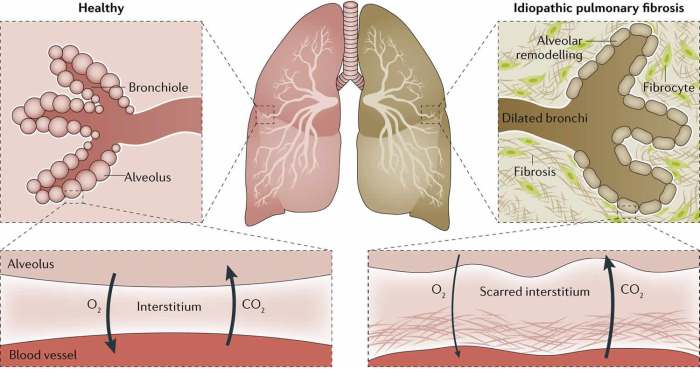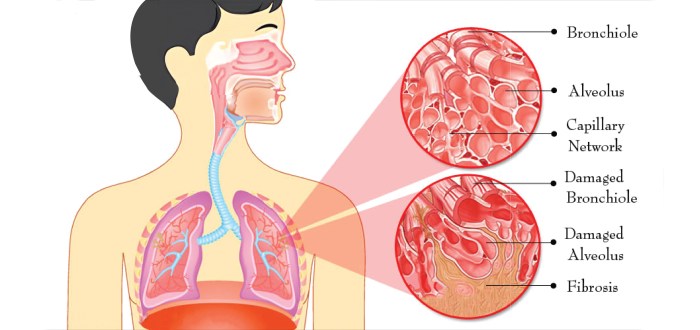Pulmonary fibrosis symptoms are a critical aspect of this debilitating condition, providing valuable insights into its progression and severity. This guide delves into the common signs and symptoms, their evolution over time, and the importance of early detection for effective management.
Understanding the symptoms of pulmonary fibrosis is essential for timely diagnosis, appropriate treatment, and improved quality of life. As the condition progresses, symptoms become more pronounced, impacting daily activities and overall well-being.
Definition of Pulmonary Fibrosis: Pulmonary Fibrosis Symptoms

Pulmonary fibrosis is a chronic and progressive lung disease characterized by the scarring and thickening of the lung tissue. This scarring makes it difficult for oxygen to pass from the lungs into the bloodstream, leading to shortness of breath and other respiratory problems.
The exact cause of pulmonary fibrosis is often unknown, but it can be caused by a variety of factors, including exposure to certain toxins, autoimmune diseases, and certain medications. People who smoke cigarettes are also at an increased risk of developing pulmonary fibrosis.
Risk Factors
There are several risk factors associated with pulmonary fibrosis, including:
- Smoking
- Exposure to certain toxins, such as asbestos, silica, and beryllium
- Autoimmune diseases, such as rheumatoid arthritis and lupus
- Certain medications, such as methotrexate and amiodarone
- Family history of pulmonary fibrosis
Symptoms of Pulmonary Fibrosis
Pulmonary fibrosis is a chronic lung disease that causes scarring of the lung tissue. The scarring makes it difficult for the lungs to work properly, which can lead to a variety of symptoms.The most common symptoms of pulmonary fibrosis include:* Shortness of breath, especially with exertion
- Dry cough
- Fatigue
- Weight loss
- Aching muscles and joints
- Clubbing of the fingers and toes (in some cases)
The symptoms of pulmonary fibrosis can vary depending on the severity of the disease. In the early stages of the disease, symptoms may be mild and intermittent. However, as the disease progresses, symptoms can become more severe and постоянный.The following table lists the most common symptoms of pulmonary fibrosis and their severity levels:| Symptom | Mild | Moderate | Severe ||—|—|—|—|| Shortness of breath | Occasional with exertion | With minimal exertion | At rest || Dry cough | Intermittent | Persistent | Constant || Fatigue | Mild | Moderate | Severe || Weight loss | 5-10 pounds | 10-20 pounds | More than 20 pounds || Aching muscles and joints | Mild | Moderate | Severe || Clubbing of the fingers and toes | Not present | Mild | Severe |
Diagnosis of Pulmonary Fibrosis

Diagnosing pulmonary fibrosis can be challenging, as its symptoms often overlap with those of other respiratory conditions. A thorough evaluation is necessary to confirm the diagnosis and rule out other potential causes.
Imaging Tests
Imaging tests, such as chest X-rays and high-resolution computed tomography (HRCT) scans, play a crucial role in diagnosing pulmonary fibrosis. Chest X-rays may reveal characteristic abnormalities in the lungs, while HRCT scans provide more detailed images that can help identify specific patterns associated with the condition.
Lung Function Tests
Lung function tests measure the amount of air that can be inhaled and exhaled, as well as the efficiency of gas exchange in the lungs. These tests can help determine the severity of pulmonary fibrosis and monitor its progression over time.
Biopsies
In some cases, a biopsy may be necessary to confirm the diagnosis of pulmonary fibrosis. A biopsy involves removing a small sample of lung tissue for examination under a microscope. This can help differentiate pulmonary fibrosis from other conditions with similar symptoms.
Differential Diagnosis
Differential diagnosis is essential to rule out other conditions that may mimic the symptoms of pulmonary fibrosis. These include chronic obstructive pulmonary disease (COPD), asthma, and interstitial lung diseases caused by autoimmune disorders or environmental exposures.
Treatment Options for Pulmonary Fibrosis

Pulmonary fibrosis is a chronic and progressive lung disease that can lead to scarring and stiffening of the lungs. There is no cure for pulmonary fibrosis, but treatments can help to slow the progression of the disease and improve symptoms.
The goals of treatment for pulmonary fibrosis include:
- Relieving symptoms
- Slowing the progression of the disease
- Improving quality of life
The specific treatment plan for pulmonary fibrosis will vary depending on the individual patient and the severity of the disease.
Medications
There are several medications that can be used to treat pulmonary fibrosis. These medications include:
- Anti-inflammatory medications: These medications can help to reduce inflammation in the lungs.
- Immunosuppressant medications: These medications can help to suppress the immune system and reduce the production of scar tissue.
- Anti-fibrotic medications: These medications can help to slow the progression of scarring in the lungs.
Medications can be taken orally, inhaled, or given intravenously.
Oxygen Therapy
Oxygen therapy can help to improve oxygen levels in the blood. This can help to relieve symptoms such as shortness of breath and fatigue.
Oxygen therapy can be given through a nasal cannula, a mask, or a ventilator.
Pulmonary Rehabilitation
Pulmonary rehabilitation is a program of exercise and education that can help to improve the quality of life for people with pulmonary fibrosis.
Pulmonary rehabilitation programs typically include:
- Exercise training
- Education about pulmonary fibrosis
- Nutritional counseling
- Emotional support
Pulmonary rehabilitation can help to improve exercise tolerance, reduce shortness of breath, and improve quality of sleep.
Lung Transplant
In some cases, a lung transplant may be necessary for people with pulmonary fibrosis.
A lung transplant is a major surgery that carries significant risks. However, it can be a life-saving procedure for people with severe pulmonary fibrosis.
The following table compares different treatment approaches for pulmonary fibrosis and their effectiveness:
| Treatment | Effectiveness |
|---|---|
| Medications | Can help to slow the progression of the disease and improve symptoms |
| Oxygen therapy | Can help to improve oxygen levels in the blood and relieve symptoms |
| Pulmonary rehabilitation | Can help to improve exercise tolerance, reduce shortness of breath, and improve quality of sleep |
| Lung transplant | Can be a life-saving procedure for people with severe pulmonary fibrosis |
Prognosis and Management of Pulmonary Fibrosis
Pulmonary fibrosis has a variable prognosis, influenced by several factors. The extent of lung damage, underlying cause, and individual health status all play a role. While there is no cure, treatments can help manage symptoms and improve quality of life.
Management Strategies
Management strategies focus on slowing disease progression, reducing symptoms, and improving lung function. Medications such as antifibrotics can help reduce inflammation and fibrosis. Oxygen therapy may be prescribed to supplement oxygen levels. Pulmonary rehabilitation programs, involving exercise and education, can improve breathing capacity and overall well-being.
Support Groups and Resources, Pulmonary fibrosis symptoms
Support groups provide a valuable network for patients and caregivers. They offer emotional support, share experiences, and provide information about the condition and its management. Resources such as online forums and patient advocacy organizations can also provide support and connect individuals with helpful information.
Ending Remarks
In conclusion, pulmonary fibrosis symptoms serve as a crucial indicator of the disease’s presence and progression. Recognizing and addressing these symptoms promptly is vital for effective management and improved outcomes. By staying informed and seeking medical attention at the first sign of trouble, individuals can take proactive steps to mitigate the impact of pulmonary fibrosis on their lives.
FAQ Summary
What are the early signs of pulmonary fibrosis?
Early signs may include shortness of breath, dry cough, and fatigue.
How is pulmonary fibrosis diagnosed?
Diagnosis involves a combination of physical exam, imaging tests (X-ray, CT scan), lung function tests, and biopsy.
Is pulmonary fibrosis curable?
Currently, there is no cure for pulmonary fibrosis, but treatments can slow its progression and improve symptoms.
What is the prognosis for pulmonary fibrosis?
Prognosis varies depending on the severity of the condition and individual factors, but early diagnosis and treatment can improve outcomes.